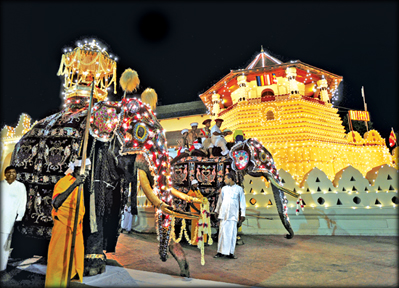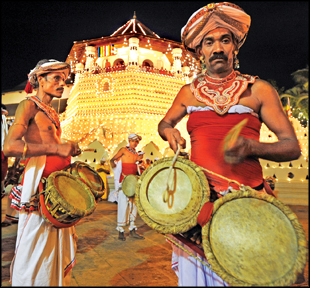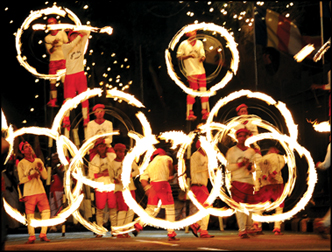|
Kandy Esala Perahera concludes:
Spectacular cultural pageant
By Indeewara THILAKARATHNE
 With the dawn of peace, the historic city of Kandy was once again lit
up to the sounds of the whip crackers heralding the commencement of the
Kandy Perahera (procession) which is one of the spectacular pageants of
the world. The pageant unfolds before the spectators from diverse parts
of the globe not only the rich socio-cultural legacy of Sri Lanka with
its unique Kandyan dance but also the unrivalled glory of the Sri Lankan
royalty as the majestic tusker adorned with colourful costumes carries
the golden casket bearing the Sacred Tooth Relic of the Buddha. With the dawn of peace, the historic city of Kandy was once again lit
up to the sounds of the whip crackers heralding the commencement of the
Kandy Perahera (procession) which is one of the spectacular pageants of
the world. The pageant unfolds before the spectators from diverse parts
of the globe not only the rich socio-cultural legacy of Sri Lanka with
its unique Kandyan dance but also the unrivalled glory of the Sri Lankan
royalty as the majestic tusker adorned with colourful costumes carries
the golden casket bearing the Sacred Tooth Relic of the Buddha.
It is the history of royalty in its pristine glory with the
confluence of the time that is unfolding before our eyes in the form of
a pageant. The impregnable city of Kandy remained as the last seat of
royalty in Sri Lanka with the Tooth Relic in the Dalada Maligawa (Temple
of the Tooth) withstanding the onslaught of invaders until the British
conquered the city in 1815. Significantly this year’s Perahera marked
the dawn of peace ending the three decades of terrorism.
The modern Perahera commenced in the reign of King Kirthi Sri
Rajasinghe (1747-1781). At the time the Sacred Tooth Relic was
considered as a property of the king and also served as a symbol of
power. Though the Tooth Relic was considered the property of the king,
the king ordered that Tooth Relic be taken in procession for the masses
to venerate it. When the British conquered Kandy with the capture of the
last king of Sri Lanka, Sri Wickrema Rajasinghe in 1815, the custody of
the Tooth Relic was handed over to the Maha Sangha (the Buddhist
clergy). In the absence of the king, a lay custodian, Diyawadana Nilame,
was appointed to attend the administrative matters in the Temple of the
Tooth.
 The Perahera was performed annually ever since the Sacred Tooth Relic
was brought to Ceylon (Sri Lanka) in the year 310 AD. According to the
history, the first Perahera was held in the city of Anuradhapura, then
the capital where the Sacred Relic was in the custody of the king.
However, with the foreign invasions and subsequent shifting of seats of
governance from Anuradhapura to Kandy. The Tooth Relic was also taken
with the king until it found its permanent abode in the ‘Dalada Maligawa’
(Palace of the Tooth Relic) constructed in the 16th century by king
Wimaladharmasuriya. Since the Tooth Relic was a symbol of power, it was
always in the custody of the king and much revered. Sinhalese classics
such as Dalada Siritha, (Chronicles of the Tooth Relic) bears testimony
to the importance of the Tooth Relic in the Sinhala culture. The Perahera was performed annually ever since the Sacred Tooth Relic
was brought to Ceylon (Sri Lanka) in the year 310 AD. According to the
history, the first Perahera was held in the city of Anuradhapura, then
the capital where the Sacred Relic was in the custody of the king.
However, with the foreign invasions and subsequent shifting of seats of
governance from Anuradhapura to Kandy. The Tooth Relic was also taken
with the king until it found its permanent abode in the ‘Dalada Maligawa’
(Palace of the Tooth Relic) constructed in the 16th century by king
Wimaladharmasuriya. Since the Tooth Relic was a symbol of power, it was
always in the custody of the king and much revered. Sinhalese classics
such as Dalada Siritha, (Chronicles of the Tooth Relic) bears testimony
to the importance of the Tooth Relic in the Sinhala culture.
The Perahera
The Esala Perehera of Kandy commences with the Kap Situveema. In a
ceremony young jak tree (Artocarpus integrifolia) is cut and planted in
each of the four Devales (temples for the god) dedicated to the four
guardian gods; Natha, Vishnu, Kataragama and the goddess of Pattini. The
four Devales were built around the Temple of the Tooth.
The ceremony was conducted to invoke blessings on the king and the
people.
Although the most famous among the Peraheras was the Randoli Perahera
which paraded the street of Kandy for five nights ending the festival
with Diya Kepima (water cutting ceremony), it is also important to look
at the other processions which make up the cultural festival of kandy
with age old customs still preserved and passed down from generation to
generation. Before the Randoli Perahera, there were four Peraheras from
the four Devales. The Kandy Perahera commences on Esala Full Moon day
(in the month of July) and concludes on Nikini Full Moon day (in the
month of August). The principal processions that constitute the Esala
festival or a cultural fiesta in Kandy are the Dalada Maligawa Perahera,
the Natha Dewala Perahera, the Maha Vishnu Dewala Perahera, the
Kataragama Dewale Perahera, and the Pattini Dewale Perahera. Over the
years this order has been maintained.
One of the fascinating features of the Esala festival of Kandy is the
tradition of announcing important events of the festival with the firing
of cannon balls. For instance, the important stages of the festival such
as the commencement of the Devale Peraheras, the placing of the casket
on the tusker’s back, the commencement of Dalada Perehera, the
completion of the Perehera, are announced with the firing of cannon
balls.
Randoli Perahera
Randoli Perahera, perhaps, the most spectacular Peraheras of the
festival commences following the five nights of Kumbal Perehera. Randoli
literally means the golden palanquins (Dolawa) on which the queen of the
serving king travelled. The spectacular pageant commences with majestic
tusker adorned with most exquisite garments, parading the street of the
historic city followed by more than hundred elephants. Perhaps, the most
colourful sight which recalls the ancient Kandyan kings and the nobility
and the bygone era of royalty is the Diyawadana Nilame and the other
officials in the attire of the traditional chieftains riding on the
elephants.
 Blowing of the conch shells, whip cracking and lighting of the
crackers serve as harbingers of the Perahera. Over the years, many a
colourful piece such as dances with drums, acrobatics, and traditional
Kandyan drummers, artists who perform against the light of flame torches
and visiting foreign artists have enriched the Kandy Perahera which is
one of the most sought after cultural events in Sri Lanka. Blowing of the conch shells, whip cracking and lighting of the
crackers serve as harbingers of the Perahera. Over the years, many a
colourful piece such as dances with drums, acrobatics, and traditional
Kandyan drummers, artists who perform against the light of flame torches
and visiting foreign artists have enriched the Kandy Perahera which is
one of the most sought after cultural events in Sri Lanka.
The Esala Perahera is considered as the blend of two distinct
Peraheras Esala and Dalada Peraheras; the Esala Perahera is believed to
have commenced in the 3rd century BC as a ritual requesting the god for
rainfall while the Dalada Perahera believed to have originated during
the 4th century AD when the Sacred Tooth Relic was brought to Sri Lanka
from India. Following the five nights of Randoli Perahera, the Kandy
Perahera concludes with Diya Kepeema or water cutting ceremony at the
Mahaweli River at Getambe, a township in the periphery of the city of
Kandy and a Day Perehera is held to mark the ceremony.
Apart from its historical and cultural importance, the Kandy Perahera
is an important anthropological event where ancient social order is
displayed in its pristine grandeur in the form of a spectacular pageant.
Most of the dancers who perform annually in the pageant are third
generation of artists whose forefathers performed the same roles in the
Perahera which they held in high esteem.
The Kandy Perahera will remain as a potent symbol of unique Sri
Lankan cultural legacy with its opulence reminding an era gone by. |

